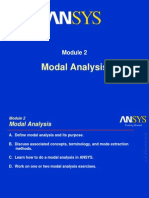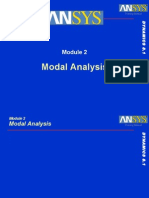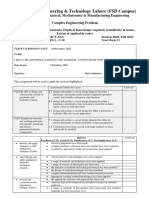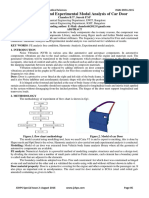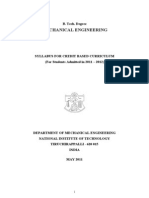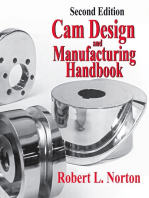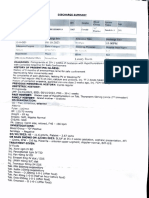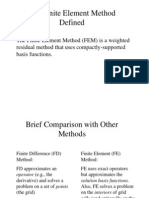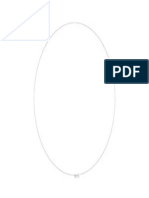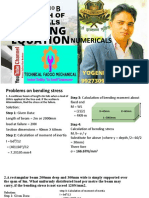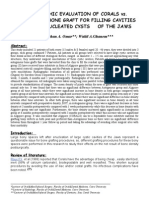Modal Analysis: Training Manual
Modal Analysis: Training Manual
Uploaded by
sandeshlikesCopyright:
Available Formats
Modal Analysis: Training Manual
Modal Analysis: Training Manual
Uploaded by
sandeshlikesOriginal Description:
Original Title
Copyright
Available Formats
Share this document
Did you find this document useful?
Is this content inappropriate?
Copyright:
Available Formats
Modal Analysis: Training Manual
Modal Analysis: Training Manual
Uploaded by
sandeshlikesCopyright:
Available Formats
Training Manual
DYNAMICS 8.1
Module 2
Modal Analysis
Module 2
Modal Analysis
Training Manual
July 22, 2004Inventory # July 22, 2004Inventory # July 22, 2004Inventory #
DYNAMICS 8.1
Modal Analysis
A. Definition & Purpose
Training Manual
DYNAMICS 8.1
Natural frequencies Mode shapes Mode participation factors (how much a given mode participates in a given direction)
July 22, 2004Inventory # July 22, 2004Inventory # July 22, 2004Inventory #
Modal Analysis
Definition & Purpose
Training Manual
DYNAMICS 8.1
Recommendation: Because a structures vibration characteristics determine how it responds to any type of dynamic load always perform a modal analysis first before trying any other dynamic analysis!
July 22, 2004Inventory # July 22, 2004Inventory # July 22, 2004Inventory #
Modal Analysis
B. Terminology & oncepts
Training Manual
DYNAMICS 8.1
} + [ C]{ u } + [ K ]{ u} = { F( t )} [ M]{ u
} + [ K ]{ u} = { 0} [ M ]{ u
u = U sin(t )
([ K ] [ M] ){ u} = {0}
2
July 22, 2004Inventory # July 22, 2004Inventory # July 22, 2004Inventory #
Modal Analysis
Terminology & oncepts
Training Manual
July 22, 2004Inventory # July 22, 2004Inventory # July 22, 2004Inventory #
DYNAMICS 8.1
Modal Analysis
Terminology & oncepts !cont."
Training Manual
July 22, 2004Inventory # July 22, 2004Inventory # July 22, 2004Inventory #
DYNAMICS 8.1
Modal Analysis # Terminology & oncepts
Mode $%traction Met&ods
Bloc" #anc$os (default) %ubspace &ower'ynamics (educed )nsymmetric 'amped (full) *( 'amped
Training Manual
July 22, 2004Inventory # July 22, 2004Inventory # July 22, 2004Inventory #
DYNAMICS 8.1
Modal Analysis # Terminology & oncepts
Mode $%traction Met&ods # Bloc' (anc)os
+fficient e,traction of large number of modes (-./) in most models 0ypically used in comple, models with mi,ture of solids1shells1beams etc! +fficient e,traction of modes in a frequency range 2andles rigid3body modes well
Training Manual
July 22, 2004Inventory # July 22, 2004Inventory # July 22, 2004Inventory #
DYNAMICS 8.1
Modal Analysis # Terminology & oncepts
Mode $%traction Met&ods # *ubspace
(equires relatively less memory but large dis"space May have convergence problems when rigid body modes are present! Not recommended when constraint equations are present! 4enerally superseded by Bloc" #anc$os
Training Manual
July 22, 2004Inventory # July 22, 2004Inventory # July 22, 2004Inventory #
DYNAMICS 8.1
Modal Analysis # Terminology & oncepts
Mode $%traction Met&ods # Po+erDynamics
(equires large amount of memory! May not converge with poorly shaped elements or an ill3 conditioned matri,! May miss modes (No %turm sequence chec") (ecommended only as a last resort for large models!
Training Manual
July 22, 2004Inventory # July 22, 2004Inventory # July 22, 2004Inventory #
DYNAMICS 8.1
Modal Analysis # Terminology & oncepts
Mode $%traction Met&ods # Reduced
Training Manual
DYNAMICS 8.1
Memory and dis" requirements are low! 5n general fastest eigen solver +mploys matri% reduction, a technique to reduce the si$e of 678 and 6M8 by selecting a subset of '9: called master '9:! (eduction of 678 is e,act but 6M8 loses some accuracy Accuracy of 6M8 depends on number and location of master '9:! 4enerally not recommended due to +,pertise required in pic"ing master '9: +fficient alternatives such as Bloc" #anc$os reduced cost of hardware
July 22, 2004Inventory # July 22, 2004Inventory # July 22, 2004Inventory #
Modal Analysis # Terminology & oncepts
Mode $%traction Met&ods # -nsymmetric
Training Manual
DYNAMICS 8.1
;alculates comple, eigenvalues and eigenvectors< (eal part is the natural frequency! 5maginary part indicates stability 3 negative means stable positive means unstable!
July 22, 2004Inventory # July 22, 2004Inventory # July 22, 2004Inventory #
Modal Analysis # Terminology & oncepts
Mode $%traction Met&ods # Damped
Training Manual
DYNAMICS 8.1
0ypical application is rotor dynamics where gyroscopic damping effects are important! 0wo AN%=% elements B+AM- and &5&+>? allow gyroscopic effects to be specified in the form of real constant %&5N (rotational speed radians1time)! ;alculates comple, eigenvalues and eigenvectors< 5maginary part is the natural frequency! (eal part indicates stability 3 negative means stable positive means unstable!
July 22, 2004Inventory # July 22, 2004Inventory # July 22, 2004Inventory #
Modal Analysis # Terminology &
oncepts
Training Manual
Mode $%traction Met&ods # .#R damped
DYNAMICS 8.1
:aster and more stable than the e,isting 'amped %olver @or"s with poorly conditioned models All forms of damping allowed including damper elements ;ombines the best features of the real eigensolution method (Bloc" #anc$os) and the ;omple, 2essenberg method (*( Algorithm) 9utputs comple, eigenvalues ( frequency and stability) and damping ratio of each mode %upports the use of a material dependent damping ratio 6M& 'M&(8 in a subsequent mode superposition harmonic analysis
July 22, 2004Inventory # July 22, 2004Inventory # July 22, 2004Inventory #
Modal Analysis # Terminology & oncepts
Mode $%traction Met&ods # .#R damped
Training Manual
DYNAMICS 8.1
M9'9&0 *('AM& NM9'+
July 22, 2004Inventory # July 22, 2004Inventory # July 22, 2004Inventory #
Modal Analysis # Terminology & oncepts
Mode $%traction Met&ods # .#R damped
Training Manual
DYNAMICS 8.1
;omparison 'emonstrating the %uperior %olution &erformance of the *( 'amped Mode +,traction Method
:+A Model ;haracteristics< >>> >2A active dofs >. damped modes Alpha Beta and +lement damping
160000 140000 120000 100000 80000 60000 40000 20000 0 QRDAMP DAMP CPU (sec) ELAPSE (sec)
July 22, 2004Inventory # July 22, 2004Inventory # July 22, 2004Inventory #
Modal Analysis # Terminology & oncepts
*ummary for symmetric, undamped sol/ers
+,traction method Bloc" #anc$os %ubspace #inear %olver )sed Sparse Matrix (r "ta% S %)er (emar"s
Training Manual
DYNAMICS 8.1
&owerdynamics
PC3 s %)er
(educed
(r "ta% S %)er
Rec !!e"#e# $ r ! st app%icati "s& M st sta'%e& Sta'%e '*t s% +& Re,*ires %ar-e #is. space& /as #i$$ic*%t0 +it1 c "strai"t e,*ati "s 2 ri-i# ' #0 ! #es Sa!e as s*'space '*t +it1 PC3 s %)er& Ca" 1a"#%e )er0 %ar-e ! #e%s& L*!pe# !ass "%0& Ma0 !iss ! #es& M #es ca"" t 'e *se# i" s*'se,*e"t spectr*! a"# PSD a"a%0ses 4" -e"era% $astest& Acc*rac0 #epe"#s " Master D5( se%ecti "& Li!itati "s si!i%ar t S*'space& 6 t rec !!e"#e# #*e t expertise re,*ire# i" se%ecti"- Master D5(7
July 22, 2004Inventory # July 22, 2004Inventory # July 22, 2004Inventory #
Modal Analysis
. Procedure
Training Manual
DYNAMICS 8.1
July 22, 2004Inventory # July 22, 2004Inventory # July 22, 2004Inventory #
Modal Analysis Procedure
Build t&e Model
Training Manual
July 22, 2004Inventory # July 22, 2004Inventory # July 22, 2004Inventory #
DYNAMICS 8.1
Modal Analysis Procedure
&oose Analysis Type & 0ptions
Build the model
Training Manual
DYNAMICS 8.1
B'iscussed ne,t
July 22, 2004Inventory # July 22, 2004Inventory # July 22, 2004Inventory #
Modal Analysis Procedure
&oose Analysis Type & 0ptions
Training Manual
DYNAMICS 8.1
Mode e,traction options Met&od: Bloc" #anc$os recommended for most applications! 1umber of modes: Must be specified (e,cept (educed method)! 2re3uency range: 'efaults to entire range but can be limited to a desired range (:(+*B to :(+*+)! *pecification of a fre3uency range re3uires additional factori)ations and it is typically faster to simply re3uest a number of modes +&ic& +ill o/erlap t&e desired range. 1ormali)ation: 'iscussed ne,t!
defaults to >eC
July 22, 2004Inventory # July 22, 2004Inventory # July 22, 2004Inventory #
Modal Analysis Procedure
&oose Analysis Type & 0ptions
Training Manual
DYNAMICS 8.1
Normali$ation to mass matri, is the default and is required for a spectrum analysis or if a subsequent mode superposition analysis is planned! ;hoose normali$ation to unity when you want to easily compare relative values of displacements throughout the structure! Modes normali$ed to unity cannot be used in subsequent mode superposition analyses (transient harmonic spectrum or random vibration)
July 22, 2004Inventory # July 22, 2004Inventory # July 22, 2004Inventory #
Modal Analysis Procedure
&oose Analysis Type & 0ptions
2ave element stresses calculated! 'o a subsequent spectrum or mode superposition analysis!
Training Manual
July 22, 2004Inventory # July 22, 2004Inventory # July 22, 2004Inventory #
DYNAMICS 8.1
Modal Analysis Procedure
&oose Analysis Type & 0ptions
Training Manual
July 22, 2004Inventory # July 22, 2004Inventory # July 22, 2004Inventory #
DYNAMICS 8.1
Modal Analysis Procedure
&oose Analysis Type & 0ptions
Mainly used for slender beams and thin shells or for wave propagation problems! Automatically chosen for &ower'ynamics method! :or &re3stressed modal analysis (discussed later)!
Training Manual
DYNAMICS 8.1
)sed only if 'amped mode e,traction method is chosen! 'amping ratio alpha damping and beta damping are allowed! B+AM- and &5&+>? also allow gyroscopic damping! All types of damping are allowed!
July 22, 2004Inventory # July 22, 2004Inventory # July 22, 2004Inventory #
Modal Analysis Procedure
Apply B 4s and *ol/e
Build the model ;hoose analysis type and options
Training Manual
July 22, 2004Inventory # July 22, 2004Inventory # July 22, 2004Inventory #
DYNAMICS 8.1
Modal Analysis Procedure
Apply B 4s and *ol/e
Training Manual
July 22, 2004Inventory # July 22, 2004Inventory # July 22, 2004Inventory #
DYNAMICS 8.1
Modal Analysis Procedure
... Apply B 4s and *ol/e
Training Manual
DYNAMICS 8.1
:ull Model
%ymmetry B;
Anti3%ymmetry B;
July 22, 2004Inventory # July 22, 2004Inventory # July 22, 2004Inventory #
Modal Analysis Procedure
Apply B 4s and *ol/e
Training Manual
DYNAMICS 8.1
:or the plate3with3hole model the lowest non3$ero mode for the full and the quarter3symmetry case is shown below! 0he DE32$ mode was missed by the anti3symmetry case because (90F is non3$ero along the symmetry boundaries!
July 22, 2004Inventory # July 22, 2004Inventory # July 22, 2004Inventory #
Modal Analysis Procedure
Apply B 4s and *ol/e
Training Manual
July 22, 2004Inventory # July 22, 2004Inventory # July 22, 2004Inventory #
DYNAMICS 8.1
Modal Analysis Procedure
Re/ie+ Results
Build the model ;hoose analysis type and options Apply boundary conditions and solve
Training Manual
DYNAMICS 8.1
July 22, 2004Inventory # July 22, 2004Inventory # July 22, 2004Inventory #
Modal Analysis Procedure
Re/ie+ Results
Training Manual
July 22, 2004Inventory # July 22, 2004Inventory # July 22, 2004Inventory #
DYNAMICS 8.1
Modal Analysis Procedure
Re/ie+ Results
Training Manual
July 22, 2004Inventory # July 22, 2004Inventory # July 22, 2004Inventory #
DYNAMICS 8.1
Modal Analysis Procedure
Re/ie+ Results
Training Manual
July 22, 2004Inventory # July 22, 2004Inventory # July 22, 2004Inventory #
DYNAMICS 8.1
Modal Analysis Procedure
Re/ie+ Results
Training Manual
July 22, 2004Inventory # July 22, 2004Inventory # July 22, 2004Inventory #
DYNAMICS 8.1
Modal Analysis Procedure
Re/ie+ Results
Training Manual
DYNAMICS 8.1
Modal stresses< Available if element stress calculation is activated when choosing analysis options! %tress values have no real meaning however these can be used to highlight hot spots 5f mode shapes are normali$ed to unity you can compare stresses at different points for a given mode shape
July 22, 2004Inventory # July 22, 2004Inventory # July 22, 2004Inventory #
Modal Analysis Procedure
Re/ie+ Results
Training Manual
DYNAMICS 8.1
Mode shapes normali$ed to unity
July 22, 2004Inventory # July 22, 2004Inventory # July 22, 2004Inventory #
Modal Analysis
Procedure
Training Manual
July 22, 2004Inventory # July 22, 2004Inventory # July 22, 2004Inventory #
DYNAMICS 8.1
D. 5or's&op # Modal Analysis
Training Manual
DYNAMICS 8.1
A step3by3step description of how to do the analysis! =ou may choose to run this problem yourself or your instructor may show it as a demonstration! :ollow the instructions in your Dynamics 5or's&op supplement ( 5*2: Modal Analysis # Plate +it& a 6ole, Page 5*#78 )! 0his is left as an e,ercise to you! :ollow the instructions in your Dynamics 5or's&op supplement ( 5*9: Modal Analysis # Model Airplane 5ing, Page 5*#29 )!
July 22, 2004Inventory # July 22, 2004Inventory # July 22, 2004Inventory #
You might also like
- 1432 Student Manual PDFDocument68 pages1432 Student Manual PDFLa puta K te parioNo ratings yet
- Theory and Application of Statistical Energy AnalysisDocument292 pagesTheory and Application of Statistical Energy AnalysisyoosefNo ratings yet
- Dynamic Analysis of A Slider-Crank Mechanism, Its Construction, Working and ApplicationsDocument31 pagesDynamic Analysis of A Slider-Crank Mechanism, Its Construction, Working and ApplicationsUsman AliNo ratings yet
- Automotive Sensor Testing and Waveform AnalysisFrom EverandAutomotive Sensor Testing and Waveform AnalysisRating: 4.5 out of 5 stars4.5/5 (14)
- Work NCDocument124 pagesWork NCPurece EugenNo ratings yet
- ANSYS Modal AnalysisDocument40 pagesANSYS Modal Analysismbreuking6943No ratings yet
- ANSYS Modal AnalysisDocument40 pagesANSYS Modal AnalysisDesmond Chang100% (1)
- ANSYS Modal AnalysisDocument40 pagesANSYS Modal AnalysisR.S.Vishwakarma5904No ratings yet
- ANSYS Modal Analysis-1Document40 pagesANSYS Modal Analysis-1Bunda NauraNo ratings yet
- ANSYS Modal AnalysisDocument40 pagesANSYS Modal AnalysisG Balaji BalajiNo ratings yet
- ANSYS Modal AnalysisDocument40 pagesANSYS Modal AnalysisPavan MutalikdesaiNo ratings yet
- ANSYS Modal AnalysisDocument40 pagesANSYS Modal AnalysisKha PhucNo ratings yet
- Lecture ModalDocument39 pagesLecture ModalSargunam Sankaravadivel100% (1)
- AnsysDocument40 pagesAnsysPrabakaran ThambusamyNo ratings yet
- Best Seminar Topics WithDocument16 pagesBest Seminar Topics WithGeorge John50% (4)
- Theory of MachineDocument4 pagesTheory of MachinePradip PatelNo ratings yet
- PDF 1Document3 pagesPDF 1Piyush JNo ratings yet
- Experiment: Detection of Machine ImbalanceDocument4 pagesExperiment: Detection of Machine ImbalanceAlex Phang Wai Hong100% (1)
- Lesson Plan DRMTMR 2014 AiDocument6 pagesLesson Plan DRMTMR 2014 AiMatthew SmithNo ratings yet
- K Chart ConstructionDocument19 pagesK Chart Constructionniesa-zie-6774No ratings yet
- MEE3014 - ROBOTICS-AND-AUTOMATION - LT - 1.0 - 1 - Robotics and AutomationDocument3 pagesMEE3014 - ROBOTICS-AND-AUTOMATION - LT - 1.0 - 1 - Robotics and AutomationInzamam Ul HaqueNo ratings yet
- Radioss For Linear Analysis 10.0Document23 pagesRadioss For Linear Analysis 10.0Navyadeep SaiNo ratings yet
- Steel Pushover AnalysisDocument28 pagesSteel Pushover AnalysisDario Manrique Gamarra100% (1)
- AdvMan Technology QbankDocument24 pagesAdvMan Technology QbankSandeepKattaNo ratings yet
- Api I C1Document54 pagesApi I C1mihai37No ratings yet
- Maxon Motor SpecificationDocument60 pagesMaxon Motor Specificationkuldeepsingh055No ratings yet
- 2020-MC-274 System 2Document17 pages2020-MC-274 System 2David James100% (1)
- Optimization of Torsional Stiffness of A Eicher 11.10 Chesis Using Evolutionary Methods With A Heterogeneous Genotype RepresentationDocument4 pagesOptimization of Torsional Stiffness of A Eicher 11.10 Chesis Using Evolutionary Methods With A Heterogeneous Genotype RepresentationSaikiranSayabugariNo ratings yet
- Me4216: Industrial Robot: Objective: For Students ToDocument4 pagesMe4216: Industrial Robot: Objective: For Students ToNguyễn SơnNo ratings yet
- Complex Engineering ProblemDocument13 pagesComplex Engineering ProblemMuhammad AbubakarNo ratings yet
- Report Self-Balancing SkateDocument17 pagesReport Self-Balancing SkateDhruvesh PatelNo ratings yet
- KTU BTech MR 2019scheme 2019Scheme-MinorsDocument49 pagesKTU BTech MR 2019scheme 2019Scheme-Minorsregret0987654321098765No ratings yet
- Jchps 17 Chandru 85-88Document4 pagesJchps 17 Chandru 85-88suresh puranic mathNo ratings yet
- EMM3223 Assignment1 2010 2011 2Document4 pagesEMM3223 Assignment1 2010 2011 2Emoxie X - StabyielzNo ratings yet
- SP+HP TK F5Document7 pagesSP+HP TK F5ariff riekoNo ratings yet
- Theory of Machine NewDocument72 pagesTheory of Machine NewSaquibh ShaikhNo ratings yet
- M2 ModalDocument20 pagesM2 Modalinam758388No ratings yet
- Ece2008 Robotics-And-Automation Eth 2.0 40 Ece2008Document2 pagesEce2008 Robotics-And-Automation Eth 2.0 40 Ece2008Raj GaneshNo ratings yet
- Tearing Partitioning AlgorithmsDocument24 pagesTearing Partitioning AlgorithmsNishith TripathiNo ratings yet
- EC302 Digital Integrated Circuits and Applications: With Effect From The Academic Year 2012-13Document6 pagesEC302 Digital Integrated Circuits and Applications: With Effect From The Academic Year 2012-13J RaviNo ratings yet
- MITRES2 002S10 Nonlinear Lec1 13Document285 pagesMITRES2 002S10 Nonlinear Lec1 13Ahmed AbbassNo ratings yet
- The Modified AftvDocument31 pagesThe Modified AftvIkramNo ratings yet
- Genetic Algorithm2Document7 pagesGenetic Algorithm2Vaishnavi B VNo ratings yet
- Presentacion de Diseno UnoDocument12 pagesPresentacion de Diseno UnoMILTON CESAR ARRECHEA RIVASNo ratings yet
- Short Term TrainingDocument5 pagesShort Term TrainingGetachew TikueNo ratings yet
- Short Term TrainingDocument5 pagesShort Term TrainingGetachew TikueNo ratings yet
- Industrial RoboticsDocument3 pagesIndustrial RoboticsSubhasish MahapatraNo ratings yet
- 15Mc702 Automotive Electronics 3 0 0 3 Course ObjectivesDocument2 pages15Mc702 Automotive Electronics 3 0 0 3 Course ObjectivesKARRTHIK R SNo ratings yet
- UG Syllabus 2010 11 NITtDocument33 pagesUG Syllabus 2010 11 NITtNitin VarmanNo ratings yet
- Workshop Note On Pushover AnalysisDocument97 pagesWorkshop Note On Pushover AnalysisAnonymous xC6bM4x6U6100% (2)
- Automatic Tool Changer (ATC)Document26 pagesAutomatic Tool Changer (ATC)KUBERAN S BITNo ratings yet
- OptistructDocument85 pagesOptistructSahithyananda ShashidharNo ratings yet
- Automotive Equipment Usage and Repair StrategiesFrom EverandAutomotive Equipment Usage and Repair StrategiesRating: 5 out of 5 stars5/5 (1)
- Advanced Test Methods for SRAMs: Effective Solutions for Dynamic Fault Detection in Nanoscaled TechnologiesFrom EverandAdvanced Test Methods for SRAMs: Effective Solutions for Dynamic Fault Detection in Nanoscaled TechnologiesNo ratings yet
- 4HANA Part 2Document8 pages4HANA Part 2sandeshlikesNo ratings yet
- Scan 29 Jul 22 03 55 51Document8 pagesScan 29 Jul 22 03 55 51sandeshlikesNo ratings yet
- Adobe Scan 10 Oct 2023Document2 pagesAdobe Scan 10 Oct 2023sandeshlikesNo ratings yet
- 4HANADocument8 pages4HANAsandeshlikesNo ratings yet
- XFGDFDocument1,023 pagesXFGDFsandeshlikesNo ratings yet
- Adobe Scan 10 Oct 2023Document2 pagesAdobe Scan 10 Oct 2023sandeshlikesNo ratings yet
- HVAC For BeginnersDocument695 pagesHVAC For Beginnerssandeshlikes100% (1)
- FemDocument27 pagesFemSandeep SinghNo ratings yet
- Composite Analysis in ANSYS:: Step-1Document2 pagesComposite Analysis in ANSYS:: Step-1sandeshlikesNo ratings yet
- Chapter - 3: Load and Stress AnalysisDocument23 pagesChapter - 3: Load and Stress AnalysissandeshlikesNo ratings yet
- U P H T ZJ W: Cavitated RegionDocument1 pageU P H T ZJ W: Cavitated RegionsandeshlikesNo ratings yet
- Viva QuestionsDocument3 pagesViva QuestionssandeshlikesNo ratings yet
- Drawing 1Document1 pageDrawing 1sandeshlikesNo ratings yet
- Chapter 08: TORSION of Shafts: Beam4Document7 pagesChapter 08: TORSION of Shafts: Beam4sandeshlikesNo ratings yet
- Applied Mechanics and Strength of Materials: Clemens ABDocument12 pagesApplied Mechanics and Strength of Materials: Clemens ABsandeshlikesNo ratings yet
- ErtertDocument18 pagesErtertsandeshlikesNo ratings yet
- ART202 Demonstration 2Document6 pagesART202 Demonstration 2AltairNo ratings yet
- IADC Specs Rig 12Document13 pagesIADC Specs Rig 12tafani electricalNo ratings yet
- Active Management of Third Stage of LabourDocument27 pagesActive Management of Third Stage of LabourNagamalar RajendraNo ratings yet
- Supression NetAppDocument6 pagesSupression NetAppsteve jonesNo ratings yet
- Local Development Plan ManualDocument94 pagesLocal Development Plan ManualRobel Bekele100% (1)
- Recaforte, M. (Creative Writing)Document3 pagesRecaforte, M. (Creative Writing)Marco100% (1)
- Final PaperDocument81 pagesFinal PaperRaj RoyNo ratings yet
- 4D9 Handout1Document23 pages4D9 Handout1Vassileios TsarsitalidisNo ratings yet
- Field Joint Developments and Compatibility ConsiderationsDocument13 pagesField Joint Developments and Compatibility ConsiderationsabcNo ratings yet
- Group K GrihaDocument22 pagesGroup K GrihaNEHA KUMARINo ratings yet
- Transmission Media and Antenna SystemDocument9 pagesTransmission Media and Antenna SystemgagoakogagokaNo ratings yet
- CH 34 - Total SolutionsDocument24 pagesCH 34 - Total SolutionsLemonn LemonnNo ratings yet
- SQL RevisionDocument28 pagesSQL RevisionAdiba IslamNo ratings yet
- Adsorption of Surfactants On Sand SurfacDocument13 pagesAdsorption of Surfactants On Sand SurfacBihag Shukla100% (1)
- Febrile Seizure NcbiDocument7 pagesFebrile Seizure NcbiNurul IrhamnaNo ratings yet
- Lect 10 B Numericals On Bending MomentDocument9 pagesLect 10 B Numericals On Bending MomentYogendra KumarNo ratings yet
- Chemistry Owl Book Chapter 8Document40 pagesChemistry Owl Book Chapter 8JoeNo ratings yet
- Human Robotic Interaction Seminar Report On 2018-19Document26 pagesHuman Robotic Interaction Seminar Report On 2018-19MusthafaNo ratings yet
- Histologi Pankreas Tikus Diabetes Setelah Pemberian Suspensi Biji BUAH MAKASAR (Brucea Javanica (L.) Merr)Document9 pagesHistologi Pankreas Tikus Diabetes Setelah Pemberian Suspensi Biji BUAH MAKASAR (Brucea Javanica (L.) Merr)Wizri SuharianiNo ratings yet
- Tangential and Centripetal Acceleration - Chapter 7.2Document23 pagesTangential and Centripetal Acceleration - Chapter 7.2Hafiezul HassanNo ratings yet
- Comprehension Main Idea and Supporting DetailsDocument2 pagesComprehension Main Idea and Supporting DetailsJennifer OledanNo ratings yet
- Hybrid Ceramic Ball BearingsDocument15 pagesHybrid Ceramic Ball BearingsManish PatilNo ratings yet
- URC SR 2016 Products Pp76-101 HiRes DigitalDocument26 pagesURC SR 2016 Products Pp76-101 HiRes DigitalDark ShadowNo ratings yet
- Dosing Pump Innovata Drive ConceptDocument5 pagesDosing Pump Innovata Drive ConceptgarpNo ratings yet
- Drugs Used in Peptic Ulcer 1920Document29 pagesDrugs Used in Peptic Ulcer 1920arthiNo ratings yet
- The AlchemistDocument57 pagesThe Alchemistok100% (2)
- Final PaperDocument12 pagesFinal PaperKhaled Atef ElhayesNo ratings yet
- Board of Aeronautical Engineering SB 1Document3 pagesBoard of Aeronautical Engineering SB 1Cruz PlusNo ratings yet






